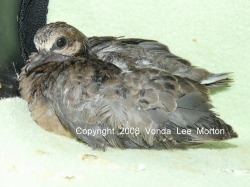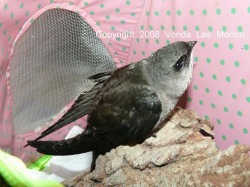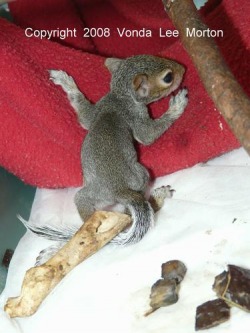Far from tapering off, things seem to be holding steady for October, with seven intakes so far for the month.
Porgy and Bess have declared their independence; Eliza still comes in at night. Mini and Albert are about two weeks from being weaned, at which time they’ll move into release phase, as well.

Mini continues to remain a tiny little thing compared to other squirrels, but she’s finally put on weight and noticeably grown, bless her little heart. Isn’t she adorable? Typical for a runt, she’s a nervous, aggressive little girl, but too cute!

Albert, aka Fat Boy, has definitely come out of his shell and is a laid-back, easygoing fellow who’s just delighted to eat nonstop. Here we have him in his daily workout - those chin-ups are pretty darned hard for a squirrel of his heft!

And who said feather season was over?? Not me! But I did expect to be receiving only injured adults for the fall and winter.
Instead, last week I received a nestling mourning dove with a wing injury - the latest I’ve ever gotten a nestling dove in to date. She’s sweetie, but the wing is troublesome. The day she came in, it was too swollen to X-ray, and when the swelling had gone down two days later and we did X-rays, they proved inconclusive. Shelley Baumann at Smalley’s said we might possibly have a broken scapula, and we both suspect this might even be a nest injury. Birds can die attempting to hatch; they can injure themselves in the process of hatching; they can have deformed legs or wings from improper positioning in the nest; their siblings can injure them in the jostling that occurs in the nest...sometimes I’m amazed that birds survive the nest at all!
At any rate, Little Dove has progressed from not using the wing at all to some limited use, so we’re watching and will probably do another X-ray next week, to see if we can get a clearer picture of what’s going on.
I also received an adult barred owl whose wing was broken. I’d talked with Steve Hicks of Bubba & Friends raptor rehab on my way to Smalley’s, as wing fractures in raptors don’t always mean a death sentence. For songbirds, they generally do, as those smaller, lighter bones generally shatter, but often a raptor, with its larger bones, will have a clean break that can be stabilized until it heals. Steve recommended we try to stabilize the wing if the break was in a long bone; unfortunately, the poor owl’s wing was shattered around the "elbow." It felt like gravel under the skin, so there was nothing we could do except humanely end the bird’s life. Neither Shelley nor I were happy about that, as other than her shattered wing, the owl was in excellent physical condition.
I know some people out there are probably wondering why we didn’t amputate the shattered wing and let the owl live. Well, for starters, it’s against federal law, and even if it weren’t, stop and think about it: what quality of life can a one-winged bird have? Put yourself in that bird’s position. Imagine being "hard-wired" for flight and never being able to take to the skies again. Nope, even if the feds allowed wing amputations, I couldn’t do that to any bird. It’s a matter of quality versus quantity of life. To offer quantity of life without quality is inhumane, in my book.

I’m actually facing that quality-quantity dilemma now with an adult chimney swift who came in with only a minor abrasion on her wing. Since I was taking the dove in for her X-ray, anyway, the swift got a vet visit, too, to make sure there was no wing fracture. There wasn’t, and she seemed so very calm that Shelley and I figured head trauma - a concussion. The next day, I took the swift outside. She tensed and lifted off my hand to fly away...and hit the ground like a brick. Now we’re thinking soft tissue injury, which doesn’t show on X-rays and may or may not heal.
There are several issues to be dealt with here, foremost the fact that this little sweetheart has about a week before she’s missed her species’ fall migration. That would mean she’d need to overwinter with me, which creates another issue: swifts eat on the wing, snagging insects and devouring them while in flight. If they cannot fly, they cannot eat, so I have to force-feed this bird every hour. She’s very good about it - doesn’t struggle, eats well - but the fact remains that she’s still stressed every time I have to handle her for feeding, and the stress is causing her to lose weight. She’s lost about 2 grams since coming in Wednesday, which doesn’t seem like a lot until you realize that it’s nearly 10% of her weight of 27g upon arrival.

And yet another issue is that swifts aren’t perching birds; they cling to vertical surfaces on the rare occasions they’re not in flight, and their feet & legs aren’t designed for long-term clinging. Their tails even have spikes to aid them in clinging to vertical surfaces - isn’t that neat?! But the long-term clinging required for a non-flighted overwintering swift, or even one with limited flight ability, will cause all kinds of foot and leg problems that are usually fatal.
I’ve been in touch with a swift specialist in Atlanta and a swift rehab group in Texas, and both say that because of these factors, swifts aren’t good candidates for overwintering. Both recommend euthanasia if she cannot make the end of the fall migration.
Obviously, I’m not thrilled at that prospect, but I knew when I signed on for this gig that it entailed difficult and all-too-frequently painful decisions. It’s not about what I want; it’s about what’s best for the animals whose lives have been entrusted to me. That’s pretty much the determining factor for any action a rehabber takes: is this in the best interests of the animal under my care? Sadly, sometimes the best interests of that animal are served by taking proactive measures to forestall future suffering, even when the animal doesn’t appear to be in any current pain.











 RSS Feed
RSS Feed
